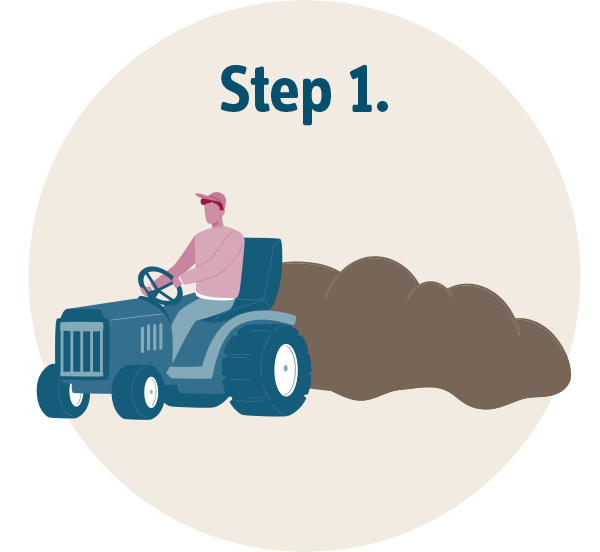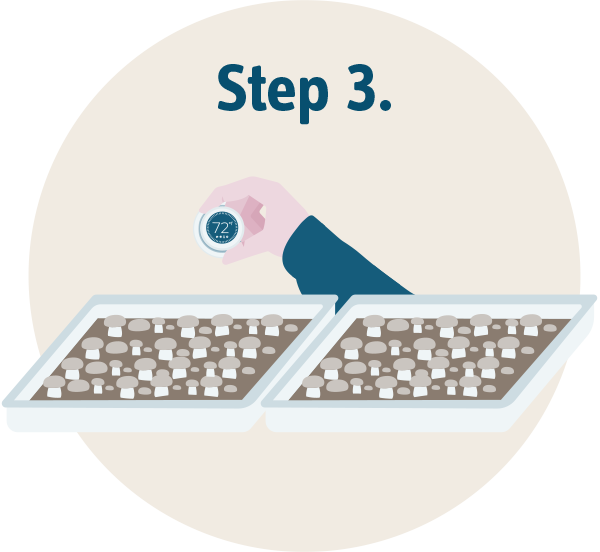Home > Mushroom safety
Which Australian Mushrooms are safe to eat?
Mushrooms are FUNGI and not a plant, therefore they grow in a very unique way. It is estimated that we know only 5% of the planet’s 2.2 – 3.8 million fungal species. Learn why Australian grown mushrooms that you purchase through reputable retailers are safe to eat, while some species found growing in the wild, could be poisonous.


How are commercial mushrooms grown?
Mushrooms are grown on farms throughout Australia. They are only grown indoors, in high-tech ‘grow rooms’ which control the environment, including temperature, water, airflow and humidity.

Farmers grow mushrooms in compost, which is pasteurised up to 80°, which ensures safe growing material.

Mushrooms are farmed in climate controlled growing rooms. First, growers add commercially produced spawn to the compost. It’s then placed on long shelves that are stacked high, like bunk beds.

Growing room temperatures are set, water is added and the mushrooms grow quickly, doubling in size every 24 hours. pasteurised up to 80°, which ensures safe growing material.

Mushrooms are carefully harvested by hand, checked, packed and sent to retailers.
Technical Fact Sheet – Fungi 101
What are fungi?
Mushrooms are FUNGI and not a plant, therefore they grow in a very unique way. Fungi are crucial decomposers and recyclers that help maintain complex ecosystems ranging from forests to agricultural crops. The fungi kingdom is vast. It’s estimated that we know only 5% of the planet’s 2.2 – 3.8 million fungal species. Fungi belong to a separate biological kingdom to that of plants, interestingly, they are more closely related to us as humans, than to plants. Fungi grow in a huge range of habitats and vary wildly in size, shape, colour, edibility and in some species, toxicity. Like humans, fungi are heterotrophs meaning they use food sources for energy. Most fungi are saprophytes (grow on non-living organic matter). Others form symbioses (such as mycorrhizal associations with plant roots) or have a parasitic relationship with living organic matter.
Fungi growth cycle
Distinct from plants and animals, fungi grow via spores (similar to the seeds of a plant). These spores form tendrils called hyphae that mature into mycelium. Mycelium is visible as fine, white strings on decomposing organic matter, either underground or within its host. When conditions are right, the mycelium forms a mushroom, which is the fruiting body of the mycelium. The mushroom appears above the surface and releases spores to continue the growing cycle.

Commercially produced mushrooms:
95% of mushrooms consumed in Australia are Agaricus bisporus. This species includes common store-bought varieties like white button mushrooms, cups, BBQ flats and their brown variety, swiss brown and portobello. Each year, Australian mushroom growers produce around 61,600 tonnes of Agaricus bisporus mushrooms, which are predominantly sold through supermarkets.
Scientific name: Agaricus bisporus
Feeding mode: Saprophytic (grow on non-living organic matter)
Further information:
- Australian mushroom farmers grow Agaricus bisporus on pasteurised compost, which is produced in highly controlled conditions.
- Agaricus bisporus spawn, is propagated in a commercial laboratory and added to the compost. Mycelium forms, and mushrooms start to grow within a few weeks.
- Agaricus bisporus is grown on beds inside specially designed and enclosed growing rooms, where farmers control and optimise the environment specifically for the species.
- Once propagated the growing cycle is very quick, taking just 6-weeks to produce three ‘flushes’ of mushrooms.
- Mushrooms are harvested by hand, one by one. They are placed in a box, and immediately chilled.
- When the growing cycle is complete, the rooms are completely cleaned out and sanitised, ready for the next crop.
Poisonous, wild mushrooms:
Wild fungi produce a range of compounds, some of which can cause serious illness or even death. The deathcap mushroom (Amanita phalloides) is responsible for most fatalities from mushroom foraging in Australia and around the world. Amanita phalloides is a different species to Agaricus bisporus, requiring a different feeding mode. However, it is visually similar to the edible variety. Do not forage wild mushrooms, as they can be hard to identify. It is simply not worth the risk.
Scientific name: Amanita phalloides
Feeding mode: Symbiotic (forms mycorrhizal associations with specific trees)
Further information:
- Deathcaps are symbiotic and can only grow in association with specific trees.
- Deathcaps produce a range of toxins (including amatoxins such as α-amanitin) that cause lethal liver or kidney failure. There is no effective antidote available.
- Poisonous mushrooms are only found in the wild. There is a serious risk of illness or even death if toxic mushrooms are mistakenly picked and consumed. If in doubt, don’t!

© 2023 by Hort innovation

